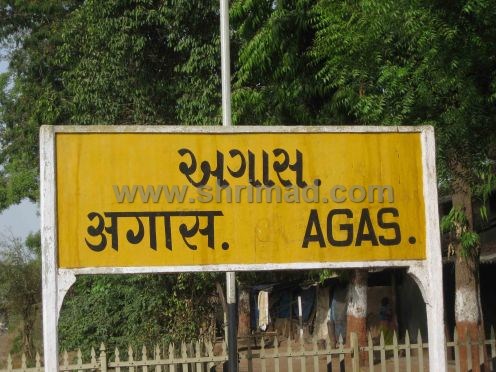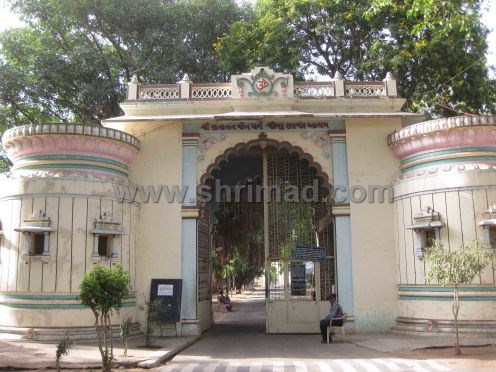Site menu:
AgasAshram
- Since the people suferring from fire of the wordly life began to feel the cooling effect of ambrosial teaching of the
 great man(Lalluji swami), and since they were impressed by his wonderful state of enlightenment, they thought it would be better of he could stay at one place so that they could continually get the advantage of his contact. That led to the rise of Ashram of Agas.
great man(Lalluji swami), and since they were impressed by his wonderful state of enlightenment, they thought it would be better of he could stay at one place so that they could continually get the advantage of his contact. That led to the rise of Ashram of Agas. - Prior to that Laghurajswami was mostly moving in wilderness and had earned the title of monk of woods. By staying in the ashram he had spiritual hues in the woody minds of the people in charotar area. The ashram thus became the resort for his old age like the cream coming over the surface of milk.
- The liberation-seekers, who had assembled near Agäs Rail Station in region of Gujarat, had undertaken the hard labor by raising their hoes and spades for laying the foundation of this Äshram. Hardly did they know that time that they were bringing in Charotar the Gangä of spiritualism illumined by Shrimad Rajchandra through blessed Laghuräjswämi, and that they were raising the great, reputable and tangible memorial of Shrimad Rajchandra. A list of donors was prepared at Sandesar by the end of 1919. Soon after that, about 7 acres of land near Agäs Station were procured for this Äshram and a small inn of three rooms was constructed thereon. That was the beginning of this Äshram.
Since it came into existence under the auspices of Laghuräjswämi, the devotees initially termed it as Shri Laghuräj Äshram. The great sage and the foremost devotee of Shrimad Rajchandra, however, did not want his name or any other sign to be associated with it. He knew that the well being of liberation-seekers that has occurred by virtue of Shrimad's innately staying within the true state is unrewardable. The nature of that benevolence can be comprehended only by realizing that state with the grace of Guru. In token of that benevolence, he suggested to term this tangible memorial of Shrimad as Shree Sanätan Jain Dharma Shrimad Rajchandra Äshram. It was therefore named accordingly. The Äshram continued to grow and in course of time it took the shape of a well-knit Village.
Laghuräjswämi did not look at the people from the worldly criteria of great or ordinary, prince or pauper, right or wrong, male or female, young or old etc. He used to see the soul within everyone and address as Prabhu (Lord). Moreover, godliness of spiritual greatness was shining within him and he used to inspire others to keep in mind the objective of their godliness so as to manifest the same. Hence everyone began to call him Prabhushri. Though he mainly stayed in Äshram since it was set up in 1920, he did move at various places in Gujarat, Märwäd and the southern territories, sometimes for months together.
By virtue of innate compassion he used to shower instructions from time to time for cooling down the truth-seekers suffering from heat of the worldly life. He used to extend peace to the people by directing them towards the path by which he had attained the bliss. On account of the monastic order and the long life he could move far and wide. As such, he came in contact with great many people. Moreover, his quiet state and impressive personality made his teaching acceptable to the people and raised faith within them. He had not even a trace of desire to be worshipped, honored, or adored. Having unique affection and devotion for Shrimad, he continually taught others to develop inclination and devotion towards him as the true Guru. He was thus laying in this hard time the simple, but unparalleled path to escape from the clutches of unrealized wrong gurus.
The teaching of H.H. was thus invaluable and enlivening. The worldly beings staying with wrong concept are like moving dead bodies. By virtue of his state of enlightenment he laid the Guru-Mantra in those bodies and inspired them to live for the everlasting soul. As such, many truth-seekers started coming to Äshram. They could get better advantage, if they could stay here. With that end in view the Äshram, which was initially set up with three rooms, started expanding.
Separate arrangements were made for the male celibates, who had dedicated their lives to Äshram. Similarly separate residence was provided for the celibate females. Many other spiritual aspirants adopted various types of restraints and stayed in Äshram. There were also a few laymen, who had developed detachment. They started living in Äshram along with their families while observing restraints. They used to lead the life of retirement and spend their time in uplifting their spiritual state.
A few dozen people thus began to live permanently in Äshram for resorting to spiritual pursuit. Thereby Äshram became the lively abode of devotion and wholesome contact. With the increase in the number of inmates, Äshram was expanded with the construction of additional rooms, buildings etc. In due course there was constructed a Jain temple with the steeple. Therein were installed Shwetämbar as well as Digambar idols as mentioned in the words of Shrimad. The installation ceremony was performed in the middle of 1928 under the protective umbrella of Laghuräjswämi. In the basement of the temple there is a Gurumandir, in which was installed the idol of Shrimad along with Aumkär Mantra on the very day of the installation ceremony. The installation of his footprints on the other side had already been performed earlier in 1926.
In order to accommodate the needs of increasing number of liberation-seekers the grand assembly hall, a lecture hall and library building were constructed. Moreover, an idol of Shrimad made of five non-ferrous metals was installed during 1932 in a mini temple above the grand gateway. Thus Äshram continued to expand and is still expanding. This complex has come into being out of the wilderness by virtue of the ascetic force of the great man There are other places, Äshrams and temples erected for devotion to Shrimad, but in respect of area and number of followers this Äshram has remained unique by the grace of H.H. Thousands of truth-seekers are taking its advantage even now for the sake of devotion and wholesome contact, and feel gratified.
By remaining the living spirit of Äshram from 1920 to 1936 H.H. Laghuräjswämi made it an unparalleled, live spiritual abode of devotion, place of wholesome contact and pursuit of liberation. Thereby he turned thousands of liberation-seekers towards the right path.





 Watch prabhushree live
Watch prabhushree live